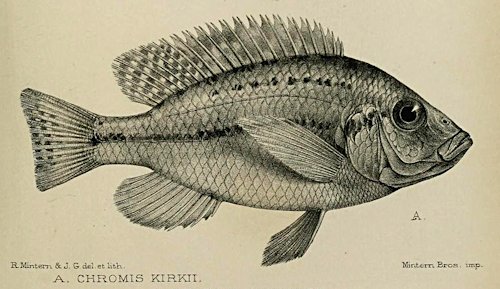
Protomelas kirkii, a female trawled in the southeast arm of Lake Malawi. Photo © by Prof. George F. Turner, used by permission |
Protomelas kirkii (Günther, 1894)
by Michael K. Oliver, Ph.D.The cichlid in the above photograph is Protomelas kirkii, one of the endemic Lake Malawi cichlids with a midlateral horizontal stripe and a less prominent stripe on the upper flank, which (along with vertical bars, not seen in the illustrated specimen) is thought to be the starting point for all melanic color patterns found in the non-mbuna haplochromines of the lake.
Protomelas kirkii was designated by Eccles & Trewavas (1989) as the type species of their new genus Protomelas. They considered P. kirkii to be the most plesiomorphic (i.e., least specialized) member of that genus. That makes this species just about the least specialized non-mbuna haplochromine in Lake Malawi, because its authors were unable to identify any synapomorphy (shared specialization) at all for the "genus" — so Protomelas is not demonstrably a real clade at all. (A clade is a group believed to contain all descendants of a common ancestor.) Protomelas is more of a wastebasket for various unspecialized Malawi haplochromines. Eccles & Trewavas regarded Protomelas as the least specialized of all (non-mbuna) Lake Malawi haplochromine genera. In fact, they compared Protomelas chiefly to several southern African riverine cichlid genera: Pharyngochromis, Chetia, and Serranochromis. As those authors acknowledged, the shared similarities between these genera and Protomelas are all plesiomorphies (unspecialized characteristics), which means the similarities provide no evidence at all for a close phylogenetic relationship among them.
Protomelas kirkii (initially called Chromis kirkii) was named for Dr. John Kirk, a Scottish medical doctor and botanist who accompanied David Livingstone on his second expedition (1858-1864; the "Zambesi expedition"). Kirk was the first person to collect fish specimens for science in Lake Nyassa (L. Malawi), and the first European to recognize that most of the lake's fishes

Protomelas kirkii, drawing from the original description of Günther (1894). Eccles & Trewavas (1989) designated this specimen (BMNH 1893.11.15:7), an immature male of 100 mm SL, as the lectotype. |
Although it is considered to be a species endemic to Lake Malawi, P. kirkii also occurs in the upper Shire River, Lake Malombe, and even much of the middle Shire as far as Kapachira Falls (also spelled Kapichira) just north of Chikwawa, Malawi, some 130 miles (209 km) downstream from Lake Malawi — a clear demonstration of how unspecialized it is for lacustrine living! Indeed, that is the furthest downstream record known for any endemic Lake Malawi cichlid (Tweddle & Willoughby, 1979).
Within Lake Malawi, P. kirkii is widely distributed from the extreme north to the southern arms. It lives primarily on sandy shallows with Vallisneria beds. Its diet consists of small invertebrates, chiefly small crustaceans and the little endemic bithyniid snail Gabbiella stanleyi found on the straplike leaves of Vallisneria. A maternal mouthbrooder, P. kirkii spawns in (sometimes communal) small bowl-shaped nests 6-8 inches (15-20 cm) in diameter in shallow water (3-6 feet or 1-2 meters), according to Eccles & Trewavas (1989), who also recorded the life coloration of sexually active males:
"Breeding males have general turquoise appearance. Head peacock blue, back and sides greenish, the individual scales of the flanks brassy at base and edged with pale blue. The mid-lateral dark band is prominent. [D]orsal and caudal fins with orange streaks or spots, the dorsal with orange lappets and a white sub-marginal band edged below by a dark band fading proximally to grey. P [pectoral fin] hyaline, V [ventral = pelvic fin] dark, with a narrow white outer border. Anal dark, with large, often elongated, cream-coloured spots."
An underwater color photo of an adult male is available at cichlidae.com (free login required).
To my knowledge, P. kirkii has not been systematically exported to the aquarium trade, but occasional individuals may have found their way into shipments. It should present no special difficulties to any aquarist with a bit of experience keeping Malawi "haps." To judge by the coloration of breeding males just described, like the apparently related P. labridens, it would be an attractive subject for a community Malawi "hap" tank, or even single-species tank.
Although P. kirkii is a rather common species on sandy weedy shores of the lake, and is not difficult to collect, it has rarely been included in any scientific studies. Apart from a listing in a table of gillnet catch statistics in the proceedings of the Lake Malawi Fisheries Management Symposium (Weyl & Weyl, 2001: 136), this species has only been employed, to my knowledge, in one early molecular phylogenetic study by Moran, Kornfield, & Reinthal (1994). Given its seemingly quite basal position within the phylogeny of the endemic haplochromine cichlids of Lake Malawi, Protomelas kirkii would appear to be a subject of considerable promise well worthy of inclusion in future phylogenetic, ecological, and evolutionary studies of this fauna.
